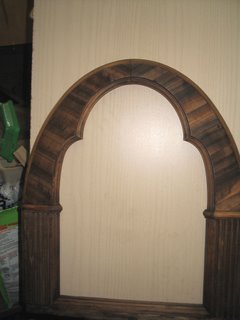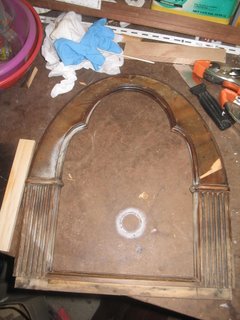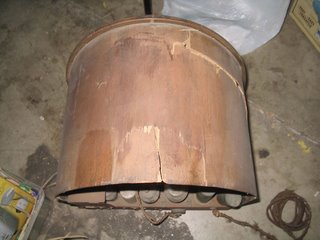I guess I jumped right in with the post about the Philco 70, and neglected to mention some of the other stuff I've been up to. So I figured it would be nice to mention some of the other radios that I've been playing with.
I've been DXing for a while, and originally I went to some swap meets looking for radios to dismantle, so that I could take the variable caps to use for antenna projects. I never did get around to the antenna projects, so after dismantling 2 dead radios, I was left with a Packard Bell 621 clock radio. I had paid $8 at the swap meet, and it actually worked. So it sat in the garage for a couple of years. Occasionally I'd turn it on, and it worked, though not well. A couple of months ago I was listening to it, when it suddenly went dead. I'd learned enough by then to figure that the problem was likely the old capacitors.
When I decided I wanted to get into old radios (30's & 40's radios are what I really like), I figured that the Packard Bell might be a good candidate for surgery practice. So I got the schematics, did a lot of reading, and purchased the parts to do a re-cap. This revived the radio from the dead. Unfortunately, the ferrite bar antenna wires are super thin, and kept breaking, so I still have to work on that. The speaker sounded awful, so I picked up a replacement at Fry's, built a mounting bracket, and got that working too. One of these days I'll finish it off, and see if I can get anything for it on eBay.
I did buy another radio on eBay. I paid about $47 for a Silvertone 2441 (that's with the shipping charges). You could see from the auction pics that it was in pretty good shape, so I went for it. Here's what it looked like when I first got it:

Pretty nice, but the cabinet was dirty, the dial cover needed some help, and of course it needed a re-cap. So I took it apart, cleaned the cabinet with naphtha, went over it with some Howard's Restore-a-Finish, and waxed it. I don't think the pictures really do it justice, but here's the cabinet when I was done:
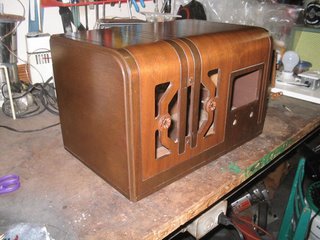
And here's what it looks like fully assembled again:

I'm sure that if I stripped it and refinished it, and made a new dial cover it could look like new, but then it wouldn't be original. Not that I'm a zealot about such things, but since this radio was in such good shape to begin with, it just seems like it would be a shame to take off the original finish. Maybe I'll find another basket case to practice on before I do the Philco 70.
As for the electronics, this is a farm radio, so that means that it is made to run off of 2 different battery voltages (90v and 1.5v). 1.5 isn't too hard to come by, but 90v batteries are expensive if you can find them. So with the assistance of Mike T., I built battery packs, and made up a connector for the radio to plug into. The 1.5v is supplied by 2 D-cells (in parallel - I had to wire this up myself, because the typical battery packs connect the batteries in series). Actually one D-cell would be enough, but wouldn't last very long. The 90v is supplied by 10 9v batteries snapped together in series. Amazingly enough, this works well, though I'm not getting much life from .99 cent store batteries.
The recap was pretty easy, and while the radio did work before the recap, I'm always amazed when something still works after I'm done with it. And it did work. Not real well, but it did pick up a couple of locals. It was about this time that I discovered the importance of the antenna. The radio was completely dead without one, but with a 10' wire, at least I could pick up my local (50Kw daytime / 20Kw night, 1/2 block away!).
As it turned out, there were still a couple of things I needed to do to get this thing working well. The first was to do an alignment. Mike sold me a signal generator pretty cheaply, and gave me a 5 minute lesson on how to do an alignment. I went through the procedure 4 times before I was satisfied that I had done the best I could. But until I discovered the last piece of the puzzle, I wasn't happy yet.
I brought the radio into the house, hooked up some wire, and picked up a couple of stations. Not good. I then connected the antenna wire to a spare wire from the phone jack. MUCH better. In fact, I discovered that if I touch the shafts of the tuner or volume control, the signal gets even better. Not wanting to hold on to the radio all the time, I asked around on the Antique Radio Forum (ARF), and found that a ground is very important for these radios. After connecting a wire from the chassis to a screw on the outlet faceplate, the radio really came to life.
It still seemed like there was a lot of static at the low end of the band though. I puzzled over this for a while (that's when I did the last of the 4 alignments), and finally it dawned on me that my DSL is connected to the other pair of wires in the phone jack. I turned off the DSL modem, and voila! The radio worked great, across the entire band.
It still works well, even with the DSL on, for listening to KKGO, which is the "nostalgia" station around here. It's really the best station for listening to on a 1940's radio, though it leaves something to be desired.
I ordered an AM transmitter kit from Goldmine Electronics. I went to put it together, and discovered that it was missing the ferrite-bar antenna. Bummer. I called them, and they're sending me a replacement. I hope it comes soon. I've already downloaded a whole CD worth of old radio programs, that I can play through the transmitter.
Anyhow, the Silvertone is pretty much finished. I just need to find some knobs, and it'll be complete.
Another project in the pipeline is the RCA clock radio that belonged to my wife:

This is a pretty standard All American 5 (AA5) design, but with a selenium rectifier. I haven't decided whether to replace it with a diode & resistor or not. This one is not much of a rush project for me, but it's in pretty good shape, so once I clean up the decades of grunge, it should look pretty nice, even if it won't be worth much. My wife thinks that the clock may not work anymore. I'll have to have a look at that, but in the meantime, I haven't even plugged this one in yet.
Which brings me to another point. These old AA5 radios can be dangerous to work on., because the plugs are not polarized, and you have a 50/50 chance that the chassis will be hot with 120v AC. So I built a combination dim-bulb tester / isolation transformer, using 2 120/24 transformers back to back. It works well, and gives me some peace of mind.
One for the "honorable mention" list is an old Montgomery Ward AA5 that I got for $5. It's kind of ugly, and apparently the antenna is missing the ferrite bar, so I don't know if it will pick anything up. It does power up though, so this might be a parts radio, or I might wind up fixing it. We'll see.
Another radio on the list is the Braun TS2:
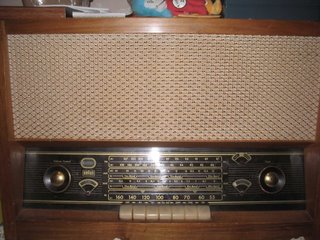
This is a nice, typical 50's German table radio. It belonged to my Mother-In-Law, who bought it new at Macy's when she lived in New York. When it still worked, it was a really nice sounding radio. Unfortunately, at some point the radio was left on (probably by me) at low volume for several weeks, and it no longer works. I plan to re-cap this one to see if that is the problem. It certainly can't hurt to replace the caps on a 50 year-old radio (well, at least if I don't manage to screw it up).
By the way, this radio is missing the knobs for bass/treble and the antenna adjuster (this just spins the ferrite antenna around inside the cabinet, to peak the signal). If you know where I can get the right knobs for this thing, please let me know.
The last radio on the list is a Telefunken console stereo that belonged to my grandmother. This is the radio that really got me into radio in the first place. It has SW, LW, AM & FM. It also has a turntable. My grandmother passed away in 1974, and this radio has resided in my mom's garage since we moved in 1978. I used to listen to it occasionally if I was in the garage, but it probably hasn't been turned on in 15 years. At on point, I replaced the turntable with a BSR, which worked really well, but I later gave the BSR to a friend, so I dropped the original turntable back in place, but didn't hook it back up. It's unfortunate that we don't have a place for this radio, because it was a really nice one. I don't expect to work on it any time soon.
So that's the list. Your comments are welcome.




